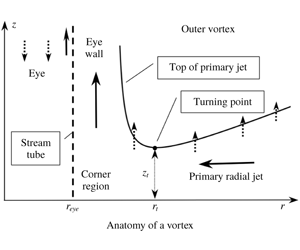Article contents
Turbulent boundary-layer flow beneath a vortex. Part 2. Power-law swirl
Published online by Cambridge University Press: 03 April 2020
Abstract

The problem formulated in Part 1 (Loper, J. Fluid Mech., vol. 892, 2020, A16) for flow in the turbulent boundary layer beneath a vortex is solved for a power-law swirl:  $v_{\infty }(r)\sim r^{2\unicode[STIX]{x1D703}-1}$, where
$v_{\infty }(r)\sim r^{2\unicode[STIX]{x1D703}-1}$, where  $r$ is cylindrical radius and
$r$ is cylindrical radius and  $\unicode[STIX]{x1D703}$ is a constant parameter, with turbulent diffusivity parameterized as
$\unicode[STIX]{x1D703}$ is a constant parameter, with turbulent diffusivity parameterized as  $\unicode[STIX]{x1D708}=v_{\infty }L$ and the diffusivity function
$\unicode[STIX]{x1D708}=v_{\infty }L$ and the diffusivity function  $L$ either independent of axial distance
$L$ either independent of axial distance  $z$ from a stationary plane (model A) or constant within a rough layer of thickness
$z$ from a stationary plane (model A) or constant within a rough layer of thickness  $z_{0}$ adjoining the plane and linear in
$z_{0}$ adjoining the plane and linear in  $z$ outside (model B). Model A is not a useful model of vortical flow, whereas model B produces realistic results. As found in Part 1 for
$z$ outside (model B). Model A is not a useful model of vortical flow, whereas model B produces realistic results. As found in Part 1 for  $\unicode[STIX]{x1D703}=1.0$, radial flow consists of a sequence jets having thicknesses that vary nearly linearly with
$\unicode[STIX]{x1D703}=1.0$, radial flow consists of a sequence jets having thicknesses that vary nearly linearly with  $r$. A novel structural feature is the turning point
$r$. A novel structural feature is the turning point  $(r_{t},z_{t})$, where the primary jet has a minimum height. The radius
$(r_{t},z_{t})$, where the primary jet has a minimum height. The radius  $r_{t}$ is a proxy for the eye radius of a vortex and
$r_{t}$ is a proxy for the eye radius of a vortex and  $z_{t}$ is a proxy for the size of the corner region. As
$z_{t}$ is a proxy for the size of the corner region. As  $r$ decreases from
$r$ decreases from  $r_{t}$, the primary jet thickens, axial outflow from the layer increases and axial oscillations become larger, presaging a breakdown of the boundary layer. For small
$r_{t}$, the primary jet thickens, axial outflow from the layer increases and axial oscillations become larger, presaging a breakdown of the boundary layer. For small  $\unicode[STIX]{x1D703}$,
$\unicode[STIX]{x1D703}$,  $r_{t}\sim z_{0}/\unicode[STIX]{x1D716}\unicode[STIX]{x1D703}$ and
$r_{t}\sim z_{0}/\unicode[STIX]{x1D716}\unicode[STIX]{x1D703}$ and  $z_{t}\sim z_{0}/\unicode[STIX]{x1D703}^{3/2}$. The lack of existence of the turning point for
$z_{t}\sim z_{0}/\unicode[STIX]{x1D703}^{3/2}$. The lack of existence of the turning point for  $\unicode[STIX]{x1D703}\gtrsim 0.42$ and the acceleration of the turning point away from the origin of the meridional plane as
$\unicode[STIX]{x1D703}\gtrsim 0.42$ and the acceleration of the turning point away from the origin of the meridional plane as  $\unicode[STIX]{x1D703}\rightarrow 0$ provide partial explanations why weakly swirling flows do not have eyes, why strongly swirling flows have eyes and why a boundary layer cannot exist beneath a potential vortex.
$\unicode[STIX]{x1D703}\rightarrow 0$ provide partial explanations why weakly swirling flows do not have eyes, why strongly swirling flows have eyes and why a boundary layer cannot exist beneath a potential vortex.
- Type
- JFM Papers
- Information
- Copyright
- © The Author(s), 2020. Published by Cambridge University Press
References
- 2
- Cited by


